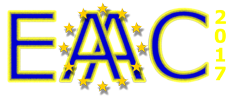Speaker
Isabel Gallardo Gonzalez
(Lund University)
Description
A parametric experimental study of ionization-induced trapping in láser wakefield acceleration is presented. Pulses from the multi-terawatt laser at Lund University are focused in a gas cell containing a variable mixture of hydrogen and nitrogen. Electron beams with continuos energy distribution up to 200 MeV are generated. When changing the composition of the gas target, a significant change in the electron beam is observed. It is found that, at high densities or high concentrations of nitrogen, the boosted electrons are emitted at a small angle with respect to the central optical axis, leading to an overall increase of the beam divergence in the laser polarization direction. It is concluded that the electromagnetic fields of the laser pulse can significantly influence the electrons trapped in the first plasma wave period. This is supported by 3D particle-in-cell simulations, showing that, if the betatron oscillation of the electrons are in resonance with the laser field, the electrons gain a significant transverse momentum from the laser fields, which can be transferred to longitudinal momentum via the magnetic part of the Lorentz force. This process is also known as direct laser acceleration.
Primary author
Isabel Gallardo Gonzalez
(Lund University)
Co-authors
Dr
Anders Persson
(Atomic Physics, Lund University)
Dr
Bastian Aurand
(ILPP, Universität Düsseldorf, Germany)
Dr
Brigitte CROS
(LPGP-CNRS-UP11)
Prof.
Claes-Göran Wahlström
(Lund University)
Dr
Frédéric Guillaume Desforges
(Laboratoire de Physique des Gaz et des Plasmas, Université Paris-Sud XI)
Mr
Henrik Ekerfelt
(Lund University)
Dr
Martin Hansson
(Atomic Physics, Lund University)
Dr
Olle Lundh
(Lund University)
Dr
Thomas Audet
(Laboratoire de Physique des Gaz et des Plasmas, CNRS-Université Paris-Sud, 91405 Orsay)
Dr
Xavier Davoine
(CEA DAM DIF)
Dr
sandrine Dobosz Dufrénoy
(CEA-Saclay)

